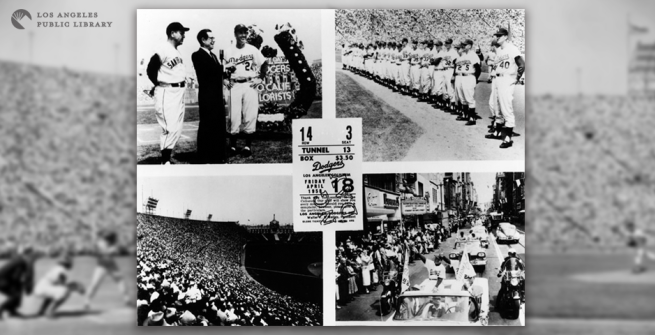On April 18, 1958, Major League Baseball finally arrived in what was then the country’s third-largest city. The brand new Los Angeles Dodgers were going to play their first official home game against their fellow, exported from New York arch-rivals, the San Francisco Giants.
For some people, Opening Day of the baseball season brings about feelings of hope and joy over getting the chance to follow their favorite team. Opening Day is a great day for those people.
For others (especially if you live near Elysian Park), Opening Day means that your neighborhood is clogged with cars and there’s a lot more garbage on the streets. And it’s really hard to get anywhere. And why does the evening commute take so long now?
In Los Angeles, there really is just one thing that everyone agrees on: traffic. And we hate it. (We also cause the traffic, but it’s always other people who cause it, right?)
And with all that was going with Major League Baseball moving to the West Coast in 1958, there was definitely one thing that seems exactly the same then as it does now: How am I going to get to the game?
On April 8, 1958, 10 days before the Los Angeles Dodgers home opener at the Coliseum (Dodger Stadium was four years and a whole bunch of legal hangups from opening), the Los Angeles Times ran a story with the headline “Ball Game Parking to Be Problem: Dodger Fans Given Advice to Prevent Tie-up at Coliseum.”
At a press conference held at the California State Museum of Science and Industry (now the California Science Center), the LAPD advised fans to take buses and avoid freeways en route to the Coliseum. Despite the increased crowd, the parking rate for the paved spots at the Coliseum (a whopping 3,400 spots in 1958) were going to remain at their posted rate: $1. (By Opening Day, this rate would go up to $2.) Some people with homes in the area were expected to charge up to $6 to let people park on their lawns.
(If you wish to talk like an Angeleno from the 1950s, don’t say that the freeways were ‘jammed” or “congested.” The word at the time was “plugged.”)
Opening Day 1958 was expected to draw a crowd of over 90,000 to the Coliseum. But, the combination of a midweek day game (April 18, 1958 was a Friday) and forecasts of horrible traffic held the crowd down to 78,672, which was a record attendance at the time. And it’s not as if people stayed home to watch the game on television. In 1958, the only Dodgers games televised in Los Angeles were 11 road games played in San Francisco. (This would be the practice through most of the 1960s.)
April 18, 1958 started with a morning ceremony at City Hall welcoming the Dodgers to Los Angeles. The Los Angeles Times estimated a crowd of about 5,000 people watched Mayor Norris Paulson welcome the team. Dodgers owner Walter O’Malley showed off the home plate from the Dodgers Brooklyn home, Ebbets Field, that had been transplanted. O’Malley was given an oversized Mexican sombrero to welcome him to Los Angeles. A parade down Broadway took the players to the Coliseum.
The Dodgers had lost two of their first three games to open the season in San Francisco, but they won their first game in Los Angeles by a 6-5 margin. Hank Sauer of the Giants hit the first big league home run in Los Angeles in the 4th inning off of Dodger starting pitcher Carl Erskine. Sauer would homer again in the 8th. Dick Gray hit the first Dodger homer in Los Angeles.
The Giants had a great chance to tie the game in the top of the ninth. Down 6-4, Jim Davenport led off with a double, knocking out Erskine and bringing in Clem Labine. Willie Kirkland followed with a triple to center that appeared to score Davenport. But, Davenport was called out on appeal for missing third base. (The LA Times headline read: “No Alibi: Davenport Admits Skull at Third Base.”) Instead of the tying run on third with no outs, it was still 6-4 with one out. Willie Mays drove home Kirkland with an infield single to make it 6-5, but Labine retired the last two Giants to preserve the Dodgers win.
Most of the crowd went home happy. Except for a handful of people who had parked their cars in a newly posted “No Parking” zone that was also a tow away zone. Those people had to go to an impound lot after the game to get their vehicles back. The princely sum to get your car out of impound in 1958: $17.50.
When Dodger Stadium opened in 1962, the newspapers were filled with predictions of traffic nightmares. The Chief of Police at the time, William Parker, advised fans to leave the game early if they wanted to get home in a decent amount of time.
So if you’re headed to Dodger Stadium on #OpeningDayLA, the parking fees range from zero (if you feel lucky and want to walk a very long way and have no fear of hills) all the way up to $50. And if you’re driving around Dodger Stadium around the time the crowd is leaving (let’s say 7:30 p.m.), please be patient. You may only have to get stuck in traffic like that another 90 times if the Dodgers can make it to Game 7 of the World Series again. And if your car gets towed, please be prepared to pay more than $17.50 to get your car out of the impound lot.
The best suggestion for getting to Dodger Stadium on Opening Day? Just walk. Start now.










